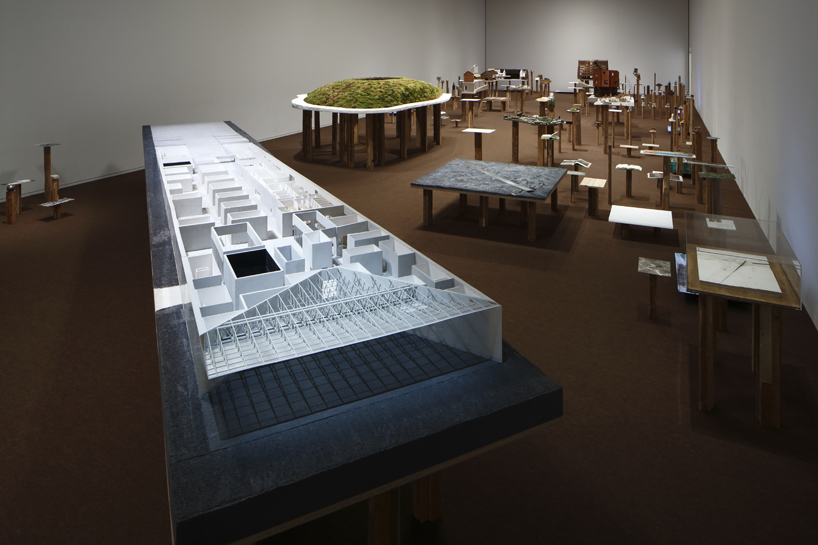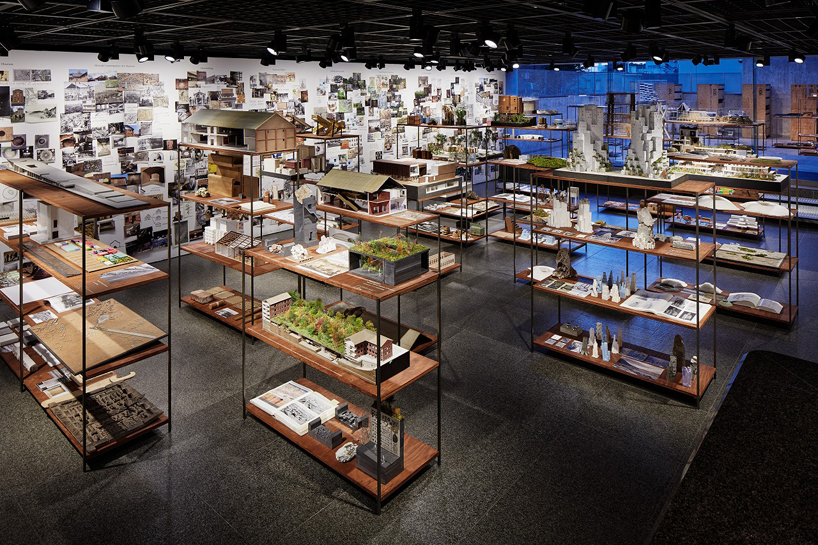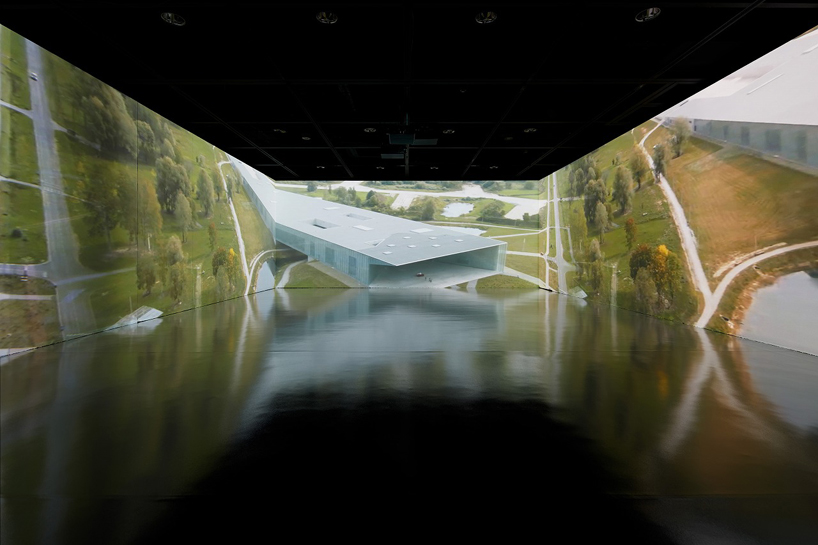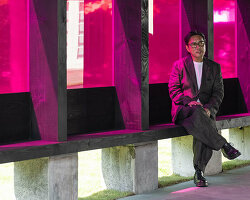Tokyo Opera City Art Gallery and TOTO GALLERY・MA present two concurrent exhibitions by japanese architect tsuyoshi tane. the two shows, united under the common theme of ‘archeology of the future,’ introduce a trajectory of tane’s intensive creative achievements and his challenge of exploring how architecture contributes to creating the future by looking into memories of a place.

tsuyoshi tane | archaeology of the future―digging & building
installation view at Tokyo Opera City Art Gallery, 2018
photo by keizo kioku
the exhibition at Tokyo Opera City Art Gallery, entitled ‘digging & building,’ introduces tane’s design method of digging and delving into memories of a place and taking a creative leap forward. it showcases his representative works created through this method including estonian national museum, kofun stadium and his latest projects using a variety of media including large-sized models and moving images in such a way that it appeal to viewers’ physical senses. meanwhile the exhibition at TOTO GALLERY・MA entitled ‘search and research‘ introduces the processes of tane’s architectural thinking and speculation and presents a methodology of ‘archeological research’ applied to all his projects.

tsuyoshi tane | archaeology of the future―digging & building
installation view at Tokyo Opera City Art Gallery, 2018
photo by keizo kioku
these two exhibitions aim to present a comprehensive view of tane’s processes of search/research: viewers can examine the implementation of this process through which tane analyzes memories of a place from different angles to establish new perspectives and develops his ideas into architecture leading to the future. memory influences the present and creates the future — tane’s creative achievements based on this belief invite each one of us, who is responsible for the present and future of our cities, to think about the potential, mission, and future possibilities of architecture.
designboom spoke with tsuyoshi tane, founder of atelier tsuyoshi tane architects, at the tokyo city exhibition to uncover the spirit of the two shows and their relationship to each other.

image © designboom
designboom (DB): the two exhibitions have the theme ‘archaeology of the future’. can you explain what this phrase means to you?
tsuyoshi tane (TT): ‘archeology of the future’ is our manifesto — we’ve been experiencing in our everyday professional lives that things are continuously being newly designed, newly projected, newly developed. our team has felt that this constant renewal is no longer so promising for our future. when I first became an architect, in the design of our project, instead of attempting to make something new, we tried to excavate the memory of what had been. there are places that have memories that are almost forgotten or have even disappeared. but I avoided this idea of trying to transform a place to push for the future. instead, aiming toward stronger, longer, more durable architecture. that is what we’re trying to express in this type of formal execution, and what provides us with one manifesto between two exhibitions.

tsuyoshi tane | archaeology of the future―digging & building
installation view at Tokyo Opera City Art Gallery, 2018
photo by keizo kioku
DB: how do the two exhibitions compare and how do they convey your work?
TT: this was challenging. we’ve spent two years of our life preparing this exhibition. of the two galleries, one is dedicated more to the arts and has a greater impact on the general public. the second is oriented more toward the architect and architecture scene. although the two are very different, viewers can visit and enjoy both. to ensure that the two experiences remained cohesive, ‘archeology of the future’, subtitled: ‘the digging of building’ became the single encompassing theme. we presented the exhibition in opera city to engage our challenging concept and convey this idea of digging both the memory as well as the idea of architecture. the show expresses how we conduct research and how we understand our memories. this idea further alludes to the physical process of construction. ‘digging and building’ becomes a continuation of our concept formalized into architecture. that’s what connects archeology and architecture. you will see the exhibition spaces resemble unfinished archeological sites. one might gaze across each object and realize that without each individual part, it is impossible to construct the project as a whole.

image © designboom
TT (continued): the exhibit at TOTO GALLERY・MA is called ‘search and research’ as we are not always sure what we are doing and we won’t know until it’s been built. it is an honest way to show how we work everyday in our office, reproducing our process of searching, thinking, and experimenting to see what we are trying to achieve by doing it. so we are trying to express how we work through models, testing objects, materiality, textures, and sketches. how we work is a mess of everything and architects are able to read this kind of complex information. it is very complex, but then I am trusting visitors to be able to imagine and make connections.

estonian national museum
film directed by hikaru fujii
installation view at Tokyo Opera City Art Gallery, 2018
photo by keizo kioku
DB: how can architects connect the history of a place to its future through architecture?
TT: when I try to differentiate between history and memory, history refers to selected information that has been arranged by somebody, or many people, that cannot change. this exhibition refers, rather, to the memory of a place with traces of its history. during the two years spent preparing this exhibition, I realized that memory does not belong to the past — memory is rather a driving force that creates something for the future. that’s why we have the knowledge and capacity as human beings to read memories and to connect them with the future.

estonian national museum
film directed by hikaru fujii
installation view at Tokyo Opera City Art Gallery, 2018
photo by keizo kioku
DB: how would you describe the evolution of your work up to now? and how do you hope to progress in the future?
TT: I started my architecture career with my winning design for the estonian national museum. it was a surprise but also my starting point to becoming an architect. I went through almost ten years considering the challenges of architecture with this idea of memories — how to create a future. more and more I began to believe that this idea could be meaningful in our contemporary, evolving society. this idea of memories can be a strong gravity toward a different kind of future in which society does not always strive toward modernization alone.

image © designboom
DB: how long have you been based in paris? how does the city compare with tokyo, or the other cities you have lived and worked in?
TT: it’s been almost twelve years that I have lived in paris, which is my base today, during which time I’d traveled between many other cities so it’s more global. tokyo is one of the cities that I always come back to. it is where I was born and where I grew up until my teenage years. tokyo has such a strong dynamic as it is a very ‘local’ city. it was made by people so it is very organic and complex. it will never be understood in the same way. although the city is very systematic there is a strong element of humanity. it is very mysterious. whereas paris is very strong for many kinds of people, religions, cultures, and politics. everyday I see a mix of human society. I notice these differences by visiting many places. sweden and denmark have also been among my bases when I was 20 years old until I was 25. living in these scandinavian countries during these developing years of my early twenties has given me a deep understanding of nature and life.

view into the exhibition at TOTO GALLERY・MA
image © nacása & partners inc.
DB: what do you think is the most important role of an architect working today?
TT: I think working hard is the most important role of architect. unfortunately architects are not strongly respected these days. we are not asked to challenge ourselves. we forget to challenge ourselves to contribute to society or to the future in a unique way. I feel more and more that, while we can not forget about design, we should focus more on ‘idea.’ we should consider how we can transform our challenges into architecture through an idea or concept rather than striving only towards a better design of a ‘good building.’

image © nacása & partners inc.

image © nacása & partners inc.

image © nacása & partners inc.

image © designboom
 image © designboom
image © designboom

image © designboom

image © nacása & partners inc.

image © designboom

image © nacása & partners inc.

image © nacása & partners inc.

tsuyoshi tane at TOTO GALLERY・MA
image © designboom












exhibition info | Tokyo Opera City Art Gallery:
title: tsuyoshi tane | archaeology of the future — digging & building
period: friday, 19 october – monday, 24 december, 2018
venue: Tokyo Opera City Art Gallery
open hours: 11:00 – 19:00 (to 20:00 on fridays and saturdays. entry up to 30 minutes before closing)
closed on: mondays (except 24 december)
exhibition info | TOTO GALLERY・MA:
title: tsuyoshi tane | archaeology of the future―search & research
dates: thursday, october 18 – sunday, december 23, 2018
hours: 11:00–18:00
closed: mondays and national holidays except december 23 (sun/ national holiday)
admission: free
venue: TOTO GALLERY・MA
organization: TOTO GALLERY・MA
planning: TOTO GALLERY・MA planning and management committee
special advisor: tadao ando
members: kazuyo sejima, manabu chiba, yoshiharu tsukamoto, erwin viray
support: ambassade de france/ institut français du japon, estonian embassy, tokyo society of architects and building engineers, tokyo association of architectural firms, the japan institute of architects kanto-koshinetsu chapter, architectural institute of japan kanto chapter
cooperation: citizen watch co., ltd., japan airlines co., ltd.
architecture interviews (267)
atelier tsuyoshi tane (10)
TOTO GALLERY MA (15)
PRODUCT LIBRARY
a diverse digital database that acts as a valuable guide in gaining insight and information about a product directly from the manufacturer, and serves as a rich reference point in developing a project or scheme.


















